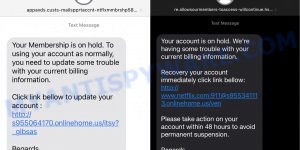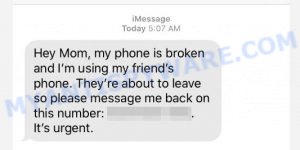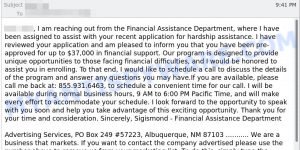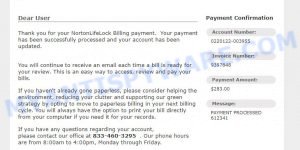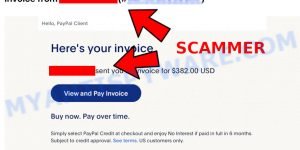Scam emails are unfortunately all too common in today’s digital age. These fraudulent messages are designed to deceive people into revealing sensitive information or taking harmful actions. One such scam email that has been making the rounds recently is a purported message from Metamask, a popular cryptocurrency wallet. The email claims that users need to verify their wallets to comply with KYC regulations, and threatens restrictions if they fail to do so. However, this email is a scam, and users should be aware of the red flags and take steps to protect themselves from falling victim to it.
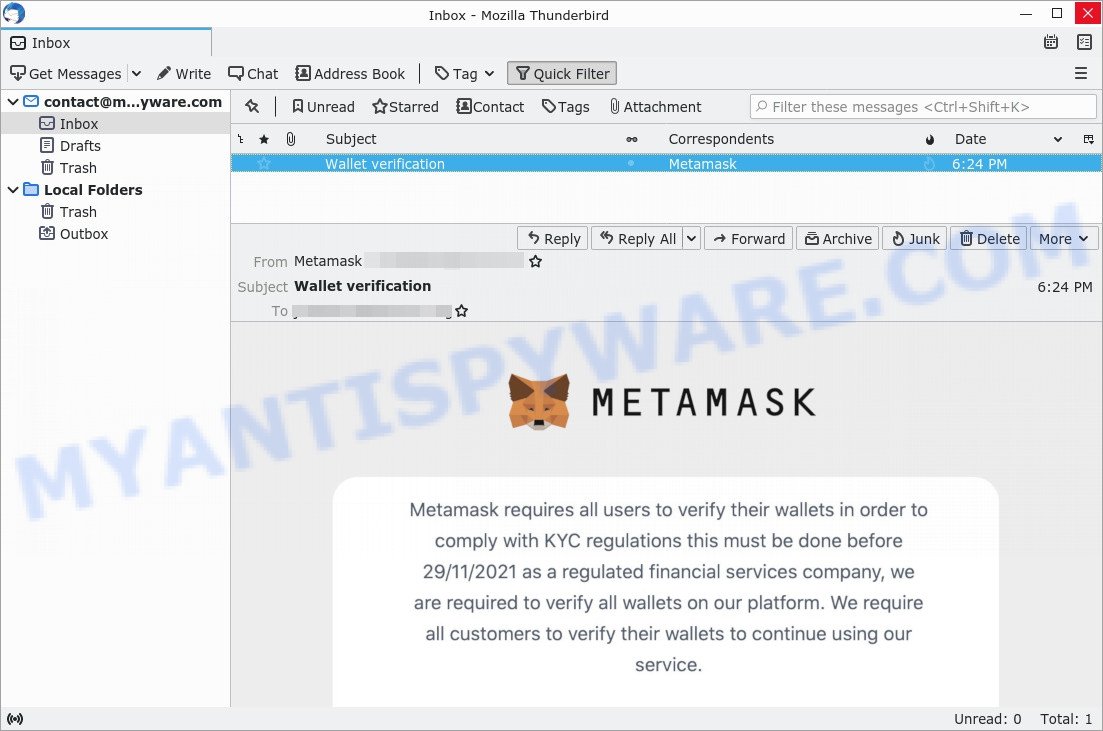
The MetaMask Wallet verification email message is a SCAM
QUICK LINKS
- How the Metamask Email Scam Works
- What To Do If You Receive A Scam Email?
- How to spot and avoid such scams
How the Metamask Email Scam Works
The Metamask email scam is a fraudulent email message that is designed to trick Metamask users into revealing their sensitive information. The email claims that the user needs to verify their wallet to comply with KYC regulations, and threatens wallet restrictions if the user fails to do so. However, this is a scam, and the email is not legitimate.
The email typically includes a link that the user is supposed to click on in order to verify their wallet. However, this link actually leads to a fake website that is designed to look like the real Metamask website. If the user enters their login credentials or other sensitive information on this website, the scammers will have access to their Metamask wallet and can steal their funds.
It is important to note that Metamask does not require wallet verification through email or any other unsolicited means. If users receive an email like this, they should not click on any links or provide any personal information. Instead, they should go directly to the Metamask website and verify the authenticity of the request. They should also report the email to Metamask support and to their email provider as a phishing attempt.
The Metamask email scam typically works in the following steps:
- The scammer sends an email to a Metamask user claiming that they need to verify their wallet in order to comply with KYC regulations.
- The email includes a link that the user is supposed to click on to verify their wallet.
- If the user clicks on the link, they are taken to a fake website that looks like the real Metamask website.
- The user is then prompted to enter their Metamask login credentials or other sensitive information, such as their private key or seed phrase.
- Once the user enters their information, the scammer can access their Metamask wallet and steal their funds.
- If the user does not realize that they have been scammed and continues to use their wallet, the scammer can continue to access their funds and potentially steal more over time.
A typical Metamask Scam Email reads as follows:
METAMASK
Metamask requires all users to verify their wallets in order to comply with KYC regulations this must be done before 19/11/2021 as a regulated financial services company, we are required to verify all wallets on our platform. We require all customers to verify their wallets to continue using our service.
What if I don’t complete the wallet verification?
If you don’t verify your wallet, your wallet will be restricted.
Verify your wallet
If the button above doesn’t work, try the page below.
[fake METAMASK link]
For further assistance with this issue, please contact our support team here.
Examples of such scams
Scammers use various tactics to steal personal information, funds, or even control of a victim’s computer. One of the most common scams is phishing, where the scammer poses as a legitimate company or organization and sends fraudulent emails or messages to trick the victim into revealing sensitive information. The Metamask Email Scam is just one example of such scams. Here are some other common examples of scams to watch out for. Walmart Order Shipped Email Scam, Geek Squad Email Scam, Netflix Account on Hold Scam, and The ‘Hi Mum’ Scam are some of the scams we reported recently.
- Netflix Membership Account on Hold Scam Text
- “Hey Mom, my phone is broken” Scam Text
- Financial Assistance Department Email Scam
- NortonLifeLock Billing Payment Scam Email
- Avira Assistance PayPal Scam Invoice Email
What To Do If You Receive A Scam Email like the Metamask Scam Email
If you receive the Metamask Scam Email, there are a few steps you can take to protect yourself:
- Do not click on any links or download any attachments in the email. This is especially important if you don’t recognize the sender or the email looks suspicious.
- Check the email address of the sender to see if it matches the official Metamask email address. If it doesn’t, or if the email address looks suspicious or unusual, do not respond to the email.
- Verify the authenticity of the request by going directly to the official Metamask website, rather than clicking on any links in the email. Check if there are any notifications or alerts regarding wallet verification, and follow any instructions provided on the official website.
- Report the scam email to Metamask. Just email phishing@phishfort.com with the email headers and any relevant details about the scam. So they can take steps to stop the scammer from targeting other users.
- If you have already clicked on a link or provided any sensitive information, take immediate steps to secure your account. This may include changing your login credentials, enabling two-factor authentication, and monitoring your account for any unauthorized activity.
- Be vigilant in the future and educate yourself on common scams and phishing techniques so that you can recognize them and protect yourself.
Remember, scammers are constantly coming up with new tactics to try and steal personal information and funds, so it’s important to stay informed and be cautious when receiving unsolicited emails or messages.
Threat Summary
| Name | Metamask Email Scam |
| Type | Phishing |
| Fake claims | The email claims that Metamask requires all users to verify their wallets in order to comply with KYC regulations, and that failure to do so will result in restricted access to the wallet. |
| Damage | The scammer may attempt to steal personal information or funds from the victim’s wallet. |
| Distribution methods | |
| Target Audience | Metamask users and investors |
| Prevention Tips | 1) Verify the authenticity of any request by going directly to the official Metamask website, rather than clicking on any links in the email. 2) Check the email address of the sender to see if it matches the official Metamask email address. 3) Be cautious of urgent or threatening language in the email. |
| Reporting Info | Report the scam email to Metamask, so they can take steps to stop the scammer from targeting other users. You can also report the scam to the relevant authorities, such as the Anti-Phishing Working Group (APWG) or the Internet Crime Complaint Center (IC3). |
How to spot and avoid phishing scams like the Metamask Email Scam

Phishing scams like the Metamask email scam can be difficult to spot, but there are several things you can do to protect yourself:
- Be wary of unsolicited emails or messages that ask you to click on a link or provide personal or sensitive information. Legitimate companies will rarely ask you to do this.
- Check the sender’s email address and look for any suspicious or unusual details. Phishing emails often use email addresses that are similar to the real company’s address, but may have small differences that can be difficult to spot.
- Look for spelling and grammar errors in the email, as these are often signs that the email is not legitimate.
- Be cautious of urgent or threatening language, such as claims that your account will be restricted or deleted if you do not take immediate action.
- Verify the authenticity of any request by going directly to the official website of the company in question, rather than clicking on any links in the email.
- Enable two-factor authentication on your accounts wherever possible, as this can provide an extra layer of security and make it more difficult for scammers to access your account.
- Keep your software and antivirus programs up-to-date, as these can help to detect and block phishing attempts.
By following these steps and remaining vigilant, you can protect yourself from falling victim to phishing scams like the Metamask email scam. Remember that if something seems suspicious or too good to be true, it probably is, and it’s always better to err on the side of caution.
Conclusion and Takeaways
In conclusion, the Metamask Email Scam is a common example of phishing scams that target cryptocurrency wallet users. Scammers use various tactics to trick victims into revealing sensitive information, such as claiming to comply with regulations or offering a sense of urgency to create a false sense of importance. To avoid falling victim to these scams, it is essential to stay vigilant and always verify the authenticity of any request before sharing personal information or clicking on any links. It is also crucial to report any suspected scams to the relevant authorities, such as the Anti-Phishing Working Group (https://apwg.org) or the Internet Crime Complaint Center (https://www.ic3.gov). By staying informed and taking necessary precautions, we can help protect ourselves from these scams and safeguard our digital assets.
